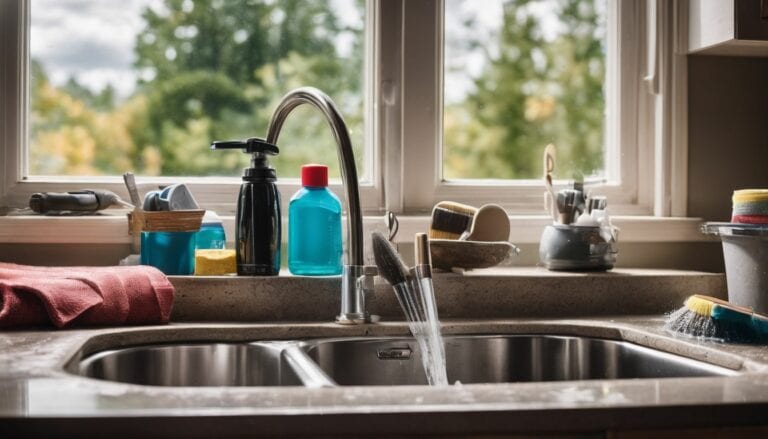Safe Lysol Use: Can It Clean Kitchen Sinks?
Ever find yourself gazing at your kitchen sink and wondering about the invisible nasties lurking there? Trust me, you’re not alone. Scary as it might sound, a study discovered that over 45% of sinks tested harbored coliform bacteria.
Yikes! But don’t fret, I’ve done all the germ-busting research for you. Let’s explore how Lysol – a well-loved disinfectant can be our secret weapon against these unwelcome visitors to maintain top-notch hygiene standards.
So stick around and join this journey into a home where clean isn’t just about looking spotless, but truly being germ-free too.
Key Takeaways
- Germs and bacteria can easily spread through sinks, making it crucial to regularly disinfect these common surfaces.
- Lysol Disinfectant Spray can be used on kitchen sinks, faucets, garbage cans, and refrigerator exteriors for effective germ-killing.
- It’s important to properly clean and disinfect different sink materials like enameled cast iron, stainless steel, and composite materials using appropriate cleaning techniques.
- Cleaning your sink is important for maintaining hygiene but may not be enough; disinfection is necessary to kill germs effectively.
The Importance of Disinfecting Common Surfaces

Germs and bacteria can easily spread through sinks, making it crucial to regularly disinfect these common surfaces.
How germs and bacteria spread through sinks
Germs and bacteria love damp spots. The sink in your kitchen is often wet. This makes it a great home for them. These tiny bugs can get on dishes, hands, or food that touch the sink.
If we do not clean our sinks well, germs grow fast. You may also move these germs to other parts of the house with your hands or dirty dishes. A quick rinse of the sink does not kill these harmful germs and bacteria either.
What areas of the sink need to be disinfected
The whole sink needs good cleaning to keep you safe from germs. This includes the faucets and any food contact areas. These spots touch a lot of things in your day, so they hold many germs.
They can lead to sickness if not cleaned well.
After pre-cleaning, rinse these parts with water. Then use Lysol Disinfectant Spray for killing the remaining bugs. It is also smart to clean around the sink too. The sides of garbage cans and fridge doors have germs as well.
Make sure you give them a wipe down! Cleaning all these parts stops bad bugs from spreading in your home.
How to Properly Clean Sink Faucets

To properly clean sink faucets, start by choosing the right cleaning products and techniques for removing buildup and stains.
Choosing the right cleaning products
I only use the best products to clean my sink. Lysol Disinfecting Wipes and Kitchen Pro Antibacterial Cleaner are my go-to items. They fight germs well. The wipes take care of the faucets every day.
The cleaner sprays work great on the rest of this kitchen sink. I also use Clorox Clean-Up Cleaner with Bleach too sometimes. It’s quite good at both cleaning and disinfecting jobs! Having a few options helps me keep everything safe, bright, and shiny in my kitchen.
Techniques for removing buildup and stains
I know how frustrating it can be to deal with buildup and stains on your sink faucets. But don’t worry, there are some simple techniques you can try to remove them. Here are a few ideas:
- Use a toothbrush: Gently scrub the affected areas with an old toothbrush. This can help loosen and remove any buildup or stains.
- Baking soda paste: Make a paste using baking soda and water. Apply it to the stains and let it sit for a few minutes before scrubbing with a cloth or sponge.
- Lemon juice: Cut a lemon in half and rub it directly onto the stains. The acidity of the lemon juice can help break down the buildup and make it easier to remove.
- Vinegar solution: Mix equal parts white vinegar and water in a spray bottle. Spray the solution onto the stains and let it sit for a few minutes before wiping clean.
- Commercial cleaners: If all else fails, you can try using a commercial cleaner specifically designed for removing buildup and stains from sinks and faucets.
The Difference Between Cleaning and Disinfecting
Cleaning and disinfecting are two different processes that serve unique purposes in maintaining a clean and safe kitchen sink.
Understanding the importance of both
Cleaning and disinfecting are both essential for maintaining a safe and healthy environment. Cleaning helps to remove dirt and dust from surfaces, while disinfecting kills harmful germs and prevents their spread.
It’s important to understand the difference between the two because just cleaning may not be enough to eliminate bacteria or viruses. By properly cleaning and disinfecting, we can ensure that our kitchen sinks, faucets, and other common surfaces remain free from pathogens that could cause illness.
So, remember to clean AND disinfect regularly to keep your kitchen safe and hygienic for everyone.
Why just cleaning may not be enough
Cleaning your kitchen sink is important for maintaining hygiene and sanitation, but it may not be enough to keep harmful bacteria and viruses at bay. While cleaning helps remove dirt and debris from surfaces, it doesn’t kill germs or disinfect effectively.
Germs can still linger on the sink even after a thorough cleaning, posing a risk to your health and safety. It’s essential to understand the difference between cleaning and disinfecting.
Cleaning involves removing visible dirt, while disinfecting involves killing germs and pathogens that you can’t see with the naked eye. To ensure proper sanitization of your kitchen sink, make sure you go beyond just cleaning by using effective disinfectants like Lysol Kitchen Pro Antibacterial Cleaner or other EPA-certified products that are specifically formulated for disinfection purposes.
How to Properly Disinfect Your Kitchen Sink
To properly disinfect your kitchen sink, start by using an EPA-certified disinfectant like Lysol. Spray the entire sink, including the faucet and drains, and let it sit for a few minutes to effectively kill germs and bacteria.
Then, scrub the sink with a brush or sponge to remove any buildup or stains. Rinse thoroughly with water to ensure all traces of disinfectant are gone.
Can you use Lysol?
Yes, you can use Lysol to disinfect your kitchen sink. Lysol Disinfectant Spray can be used on surfaces like sinks, garbage cans, and refrigerator exteriors. It is also recommended to use Lysol Disinfecting Wipes for daily cleaning and disinfection of sink faucets.
These products are effective in killing germs and bacteria that may be present on your kitchen sink. However, it is important to follow the instructions on the label and use them as directed for safe and effective disinfection.
Steps to effectively disinfect
To effectively disinfect your kitchen sink, follow these steps:
- Start by cleaning the sink basin using warm, soapy water and a sponge or cloth.
- Rinse the basin thoroughly to remove any soap residue.
- Spritz the entire sink basin with a mixture of bleach and water or an EPA – certified disinfectant.
- Let the disinfectant sit for a few minutes to effectively kill any bacteria or germs.
- Scrub the sink basin using a soap – dispensing brush and mild dish soap mixed with water.
- Pay extra attention to areas with buildup or stains, such as around the drain or faucet handles.
- Rinse the sink thoroughly with clean water to remove any remaining cleaning products.
- Dry the sink with a clean towel or let it air dry.
Tips for Disinfecting Different Materials
When it comes to disinfecting your kitchen sink, different materials require different cleaning techniques.
Enameled cast iron
When it comes to disinfecting enameled cast iron sinks, you can use warm water and regular dish soap. This will help remove any germs or bacteria without causing damage to the sink’s patina.
It is important to avoid using abrasive cleaning tools such as steel wool or wire brushes on enameled cast iron sinks, as they can scratch and ruin the finish. Remember not to use too much bleach when cleaning these sinks, as it can also cause damage.
Stick with gentle cleaning solutions and techniques to keep your enameled cast iron sink clean and disinfected.
Stainless steel
Stainless steel is a common material used for kitchen sinks because it is durable and resistant to many chemicals. However, it is important to properly clean and disinfect stainless steel to maintain its appearance and prevent damage.
When cleaning stainless steel sinks, avoid using bleach as it can be corrosive and ruin the sink. Instead, consider using Lysol Kitchen Pro Antibacterial Cleaner, which is recommended as the best cleaner for stainless steel sinks.
Additionally, be cautious when using other disinfectants on stainless steel as some may cause damage or discoloration under certain conditions. To clean stainless steel handles, knobs, and stains, use specific methods designed for this material.
Composite materials
Having a kitchen sink made of composite materials requires special care when it comes to disinfection. Composite materials, like granite or quartz composites, can be sensitive to harsh cleaners and abrasive scrubbing.
To properly disinfect a composite sink, it is recommended to use gentle cleaning products specifically designed for these materials. Avoid using bleach or abrasive cleaners as they can damage the surface.
Instead, opt for mild soap and warm water or a non-abrasive kitchen cleaner. Gently wipe down the sink with a soft cloth or sponge, ensuring that all areas are cleaned thoroughly. By following these tips, you can effectively disinfect your composite sink without causing any damage.
How to Clean Faucets and Drains
To clean faucets and drains, choose the right tools for the job and use techniques that effectively remove buildup and grime.
Choosing the right tools for the job
When it comes to cleaning and disinfecting your kitchen sink, choosing the right tools is important. You’ll need a few basic items to get the job done effectively. For cleaning faucets and drains, a scrub brush and dish soap are great options.
They can help remove dirt, grime, and buildup from these areas. If you’re dealing with clogged drains, baking soda and vinegar can be used as natural alternatives to unclog them. When disinfecting your sink, Lysol Kitchen Pro Antibacterial Cleaner is recommended as an effective solution.
However, if you prefer a more natural approach, you can also use a vinegar solution for both cleaning and disinfection purposes. By using the right tools for the job, you can keep your kitchen sink clean and germ-free.
Techniques for removing buildup and grime
Keeping your kitchen sink clean and free from grime buildup is essential for maintaining good hygiene. Here are some effective techniques you can use to remove buildup and grime from your sink:
- Use a mixture of baking soda and water: Create a paste by mixing baking soda with a small amount of water. Apply the paste to the areas with buildup and grime, then scrub gently with a sponge or cloth. Rinse thoroughly.
- Use white vinegar: Vinegar is a natural cleaner that can help remove stubborn stains and buildup. Soak a cloth or sponge in undiluted white vinegar and wipe down the affected areas. Let it sit for a few minutes, then rinse well.
- Scrub with a toothbrush: For hard-to-reach areas, such as around the faucet and drain, use an old toothbrush to scrub away grime. Apply some dish soap or a cleaning agent onto the toothbrush, then scrub vigorously to dislodge any buildup.
- Try lemon juice: The acidic properties of lemon juice can help break down grease and remove stains on your sink surfaces. Simply cut a lemon in half and rub it over the affected areas. Let it sit for a few minutes before rinsing off.
- Important Fact #5
- Important Fact #6
Safe and Effective Kitchen Disinfectants
One safe and effective kitchen disinfectant to consider is Lysol Kitchen Pro Antibacterial Cleaner.
Lysol Kitchen Pro Antibacterial Cleaner
I highly recommend using Lysol Kitchen Pro Antibacterial Cleaner to disinfect your kitchen surfaces. This cleaner is safe and effective, killing 99.9% of germs and bacteria, including salmonella.
It’s perfect for tackling tough messes in the kitchen, thanks to its powerful grease-fighting capabilities. The convenient pump spray makes it easy to apply on various surfaces, including granite countertops.
With Lysol Kitchen Pro Antibacterial Cleaner, you can trust that your kitchen will be thoroughly disinfected and free from harmful bacteria.
Other EPA-certified disinfectants
There are several other disinfectants that are EPA-certified and can be used to effectively disinfect your kitchen sink. Here are some options:
- Clorox Disinfecting Wipes: These wipes are effective against a broad spectrum of bacteria and viruses, including COVID-19. They are convenient to use and can easily be wiped across surfaces.
- Purell Multi Surface Disinfectant Spray: This spray is also EPA-certified and can kill 99.9% of germs, including bacteria and viruses. It is safe to use on various materials, such as stainless steel and enamel.
- Seventh Generation Disinfecting Multi-Surface Cleaner: This cleaner is made with botanical ingredients and is EPA-approved to kill household germs, including influenza A virus, staphylococcus aureus, and salmonella enterica.
- Pine-Sol Original Multi-Surface Cleaner: This cleaner has been trusted for years to clean and disinfect various surfaces. It is effective against bacteria and viruses and leaves a fresh pine scent.
Alternatives to Lysol
There are several alternatives to Lysol that you can use to safely disinfect your kitchen sink.
Homemade cleaning solutions
I want to talk about homemade cleaning solutions. These are great alternatives to commercial disinfectants like Lysol. Here are some options you can try:
- Hydrogen peroxide: This is a non-toxic option that can be used for bleaching, cleaning, sanitizing, and disinfecting. It’s effective against bacteria and viruses.
- DIY disinfectant spray with alcohol: You can make your own natural alternative to Lysol by mixing alcohol (at least 70% concentration) with water in a spray bottle. This solution can be used to clean and disinfect surfaces.
- White vinegar: Vinegar has high acidity, which makes it a safe alternative to bleach for disinfecting surfaces. Mix equal parts of white vinegar and water, and use it as a cleaning solution.
- Baking soda and liquid soap: These common household ingredients can be combined to create a less toxic cleaning product. Mix baking soda and liquid soap into a paste, apply it to surfaces, and scrub away dirt and grime.
Conclusion
In conclusion, it is not safe to use Lysol on your kitchen sink to disinfect. While Lysol can be used on other surfaces in the kitchen, it contains harmful chemicals if ingested. It’s important to choose a safe and effective cleaner specifically designed for disinfecting sinks.
Remember to always read and follow the instructions on product labels for proper usage.
FAQs
1. Can I use Lysol on my kitchen sink to safely disinfect?
Yes, you can use Lysol on your kitchen sink to safely disinfect. Follow the instructions on the label and make sure to rinse thoroughly after using.
2. Is it safe to use Lysol in contact with food preparation surfaces?
No, it is not recommended to directly spray or wipe Lysol onto food preparation surfaces such as countertops or cutting boards. Instead, use a food-safe disinfectant specifically designed for these surfaces.
3. How long should I leave Lysol on my kitchen sink before rinsing?
It is recommended to follow the instructions on the label of the specific Lysol product you are using as different formulations may have different contact times required for effective disinfection.
4. Can I use other cleaning products along with Lysol for better disinfection?
It is not necessary to combine multiple cleaning products for better disinfection. Using only one product according to its recommended usage instructions is sufficient.
5. Are there any precautions I need to take when using Lysol in my kitchen sink?
When using any cleaning product, including Lysol, it’s important to wear gloves and avoid getting the product in your eyes or mouth. Make sure there is adequate ventilation while applying and rinsing off the product from your kitchen sink.







